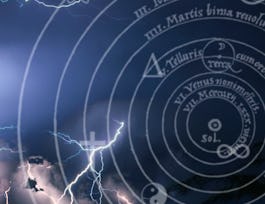For centuries we have collectively marveled at plant diversity and form—from Charles Darwin’s early fascination with stems and flowers to Seymour Krelborn’s distorted doting in Little Shop of Horrors. This course intends to present an intriguing and scientifically valid look at how plants themselves experience the world—from the colors they see to the sensations they feel. Highlighting the latest research in genetics and more, we will delve into the inner lives of plants and draw parallels with the human senses to reveal that we have much more in common with sunflowers and oak trees than we may realize. We’ll learn how plants know up from down, how they know when a neighbor has been infested by a group of hungry beetles, and whether they appreciate the music you’ve been playing for them or if they’re just deaf to the sounds around them. We’ll explore definitions of memory and consciousness as they relate to plants in asking whether we can say that plants might even be aware of their surroundings. This highly interdisciplinary course meshes historical studies with cutting edge modern research and will be relevant to all humans who seek their place in nature.



Understanding Plants - Part I: What a Plant Knows

Instructor: Professor Daniel Chamovitz, Ph.D.
Sponsored by University of Michigan
115,769 already enrolled
(1,866 reviews)
Details to know

Add to your LinkedIn profile
7 assignments
See how employees at top companies are mastering in-demand skills


Earn a career certificate
Add this credential to your LinkedIn profile, resume, or CV
Share it on social media and in your performance review

There are 7 modules in this course
Welcome to "What a Plant Knows (and other things you didn't know about plants)". If you have not already, please review the Course Syllabus for general information about this course.
What's included
9 videos1 reading1 assignment1 discussion prompt2 plugins
This week we start a systematic review of a plant's sensory systems by starting with plant responses to light. We will cover an overview of human vision, plant responses to light, Darwin's experiments showing plant responses to light, phototropism, phytochrome and flowering, and modern research on phototropism. In other words, this week we get into more advanced concepts in plant sensory biology. The last module is especially advanced, and will be clearer for those of you with a strong biology background. But do not fret, aside from very basic concepts, this module will NOT be included in the exam (you will not be responsible for understanding the intricacies of the experimental methods, etc.). If you have not already, please review the Course Syllabus for general information about this course.
What's included
7 videos1 reading1 assignment
This week we continue our systematic review of a plant's sensory systems by exploring responses to volatile chemicals (in other words, what a plant smells). We start with an overview of the plant cell, briefly review human olfaction (smell), and then explore how fruits know when to ripen. From there we go over three different experiments that explore plant responses to volatile chemicals and start exploring the controversial question, "Do plants communicate with each other?".
What's included
7 videos1 reading1 assignment
This week we continue our systematic review of a plant's sensory systems by exploring responses to tactile stimulation (in other words, what a plant feels). We start with an overview of the mechano-sensory system that differentiates between different tactile stimulations, briefly review the way electricity is used in neural communication, and then explore how the Venus flytrap knows when to close, and what powers the opening and closing of the Mimosa leaves. We'll learn how plants change their structure to cope with windy conditions, and go over some of the rather complex biology that is involved in the genetic response in plants to being touched. I'll let you know what I think of the question, Do plants feel pain? And then we'll try to understand whether plants hear, and if they do, which music they prefer.
What's included
10 videos1 reading1 assignment1 discussion prompt
This week we continue our systematic review of a plant's sensory systems by exploring the 6th sense - proprioception. We start with an overview of the proprioceptive system that allows us to keep our balance and to know where are body parts are in space. Theמ we will explore how plants know up from down, using both experiments from a few hundred years ago, and experiments conducted on the space station. We'll go over the structure of roots more in detail in order to understand where the cells are that sense gravity. We'll revisit phototropism, and learn what the chemical signal is in plants that allows them to respond to light and gravity. And lastly, we'll learn what makes a plant dance.
What's included
8 videos1 reading1 assignment
This week we move beyond survey of a plant's sensory systems, and explore how plants retain, store and recall sensory information. In other words, we ask the questions, What do plants remember? We'll try to define what we mean by "memory" and briefly review different types of human memory. The we'll look at the short-term memory found in the Venus fly trap, and the long term morphogenic memory first described 50 years ago by the Czech scientist Rudolf Dostal. We'll have a guest lecture from Prof. Nir Ohad about epigenetics and the long-term memory of winter, and even the role of epigenetics in trans-generational memory.
What's included
6 videos1 reading1 assignment1 discussion prompt
This is the final week in our journey through a plant's sense of the world. This week's lecture has two separate parts. In the first part, we continue last week's discussion of a plant's ability to remember to a more theoretical discussion on the definition of memory and consciousness. This leads us to the question, "Are plants intelligent?". We'll hear what some of the students in this class think of intelligence before finishing with a quick examination of "intelligence", and end with my own take on a plant's, and our place, in the world. In the second part we'll go for a tour of my lab and see our plant growth facilities. I'll give you a brief overview of one of the projects in my lab, and you'll meet a few of the students doing the research. And in the end, you'll even get to meet Dr. Aviva Katz.
What's included
6 videos2 readings1 assignment1 plugin
Instructor

Offered by
Why people choose Coursera for their career




Learner reviews
1,866 reviews
- 5 stars
85.75%
- 4 stars
11.73%
- 3 stars
1.23%
- 2 stars
0.42%
- 1 star
0.85%
Showing 3 of 1866
Reviewed on Mar 3, 2020
A perfect course to understand all senses of plants in a straightforward way and I must admit the way professor Daniel chamovitz helped me to better acknowledge this course was satisfactory for me.
Reviewed on Sep 17, 2019
I started this course with very little knowledge of biology and finished it with a solid foundation in plant biology. I'd recommend it to anybody wanting to learn more about plants.
Reviewed on Mar 14, 2021
It was very interesting to learn about research on plants and their abilities to detect and respond to a variety of stimuli and to relate that to people and our sensory experiences. Thank you!
Recommended if you're interested in Health

The University of Edinburgh

University of Zurich

University of Illinois Urbana-Champaign

Universidade de São Paulo

Open new doors with Coursera Plus
Unlimited access to 10,000+ world-class courses, hands-on projects, and job-ready certificate programs - all included in your subscription
Advance your career with an online degree
Earn a degree from world-class universities - 100% online
Join over 3,400 global companies that choose Coursera for Business
Upskill your employees to excel in the digital economy


